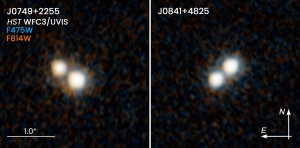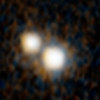A new method of determining distances in the universe uses quasars
2021.12.30 13:19 - Marek PawłowskiAstronomers use many methods of determining the distance to celestial bodies, but each of them has limits of its applicability. An international group of scientists, with the participation of Professor Marek Biesiada from the National Center for Nuclear Research, proposes the use of quasars for this purpose. The method could be applied to objects whose image reaches us even 13 billion years ago.
Quasars are extragalactic objects – the so-called active galactic nuclei, consisting of a central supermassive black hole that pulls the surrounding matter together (the so-called accretion). The accretion disk, from which material flows into the black hole, is surrounded by a spherical shell – the so-called with a hot crown, and further away from the disk, a dust torus is formed. The accretion disk radiates in ultraviolet. UV photons pass through the hot corona where free electrons have very high kinetic energies. Photons with energies in the UV range have short wavelengths – they are more „particles” than „waves”. Therefore, they interact with electrons by colliding with them like billiard balls and take energy from electrons (this is the so-called Compton phenomenon). In this way the UV photons become X photons. The relationship between the radiation powers in UV and X is non-linear, but it can be described by a mathematical model. The authors of a recently published study in the journal „Monthly Notices of the Royal Astronomical Society” showed, based on a sample of 2421 quasars collected in 2020 by the Italian team of E. Lusso and G. Risaliti, that the correlation of UV-X brightness is strongly related to distances cosmological. „This is because this correlation is established on the observed brightness levels, and it is physically responsible for the powers of UV and X radiation” – explains Prof. Marek Biesiada from the NCBJ Astrophysics Department, co-author of the work. „The observed brightness levels, in turn, depend on power and distance. Since quasars are also observed at the distances of the applicability of the standard supernova Ia method, we can measure the distance to them using two methods: SN Ia and the new one. This allows you to calibrate the quasar method. ”
Scientists expect that the new method will allow the determination of cosmological distances to very distant objects, for which the redshift „z” resulting from the expansion of the universe is even 7.5.
The authors conducted tests to verify the validity of the proposed method. One of them was the reconstruction of the Universe’s evolution according to the commonly accepted ΛCDM model: Universe with cold dark matter and with dark energy accelerating its expansion. „The data obtained using the ’quasar method’ showed, in the limit of uncertainty, a high agreement with the ΛCDM model” – says Prof. Biesiada. „We fitted the ΛCDM model to the data, where the parameters of this model were the free variables. The matter density determined on this basis is consistent with the value obtained from other cosmological observations. The essence of this work was a quasar calibration method that did not refer to the cosmological model – so as not to fall into a vicious circle, using quasars later to test cosmological models. We used stochastic Gaussian processes for this purpose. It is a statistical procedure for reconstructing the history of the universe’s expansion that relates only to data, not to a specific model. An outstanding expert in this technique is Prof. Arman Shafieloo from Korea – co-author of our work. In addition to this important publication, together with the group of Prof. Shuo Cao from Beijing, we managed (in other publications) to use quasars to test alternative theories of gravity and the transparency of intergalactic space. It is also worth mentioning that my colleagues from China have developed a different sample of quasars. This time not based on their UV and X rays, but on the angular dimensions of the quasars observed as compact radio sources. They are not used as candles, but as so-called standard rulers. Standard rulers are objects that whose physical dimensions we can know. The farther away such an object of known size is, the smaller it appears (smaller angular size). So we can determine its distance. Our sample goes just as deep in redshift and it is promising to use it together with calibrated UV-X quasars. „
Additional information:
Determining distances in the universe is not easy. While the distance to the moon can be determined by radar or laser (the first astronauts on the moon left a mirror on its surface for this purpose), there is a much bigger problem with other objects. On the so-called cosmic distance ladder, we have many methods for determining distances to different (differently distant) objects in space. The first rungs are methods that allow you to determine distances in the solar system and its immediate vicinity. The next steps allow you to determine the distances in the Galaxy, and the next – to other galaxies. The distance to the Sun, about 150 million kilometers from us, is measured by the parallax method. This method determines the angle the object has moved in front of distant stars when the observer changes position. To illustrate the method, you can look at the exposed finger of an outstretched hand alternately through the right and left eye, closing the other eye. The finger changes position in relation to the background. This is how our brain judges distances to different objects. In astronomy, parallax measurement allows you to measure distances to the Sun, planets of the solar system and the nearest stars. For example, Pluto is about 6 billion kilometers or 5.5 light-hours from the Sun, and Proxima Centauri, our closest extrasolar star, is over 4 light-years away. The angle by which the object moves in relation to the background decreases with the distance, which means that we are not able to measure the distance with this method.
The closest extrasolar star to us over 4 light years. The angle by which the object moves in relation to the background decreases with the distance, which means that we are not able to measure the distance with this method.
The closest major galaxy to us is M31 in the constellation Andromeda. It is located approximately 2.5 million light years from us. For such distant objects, the next rung of the distance ladder is used, the so-called „standard candles”. For example, when we move a kilometer away from a candle or bulb, it will be much less visible. Ten kilometers away, the picture will be even fainter. Using this relationship and knowing the brightness of the light source, we can determine the distance from which we observe a given object. In the method of standard candles in astronomy, among others, Cepheids are used – physically variable stars whose periods of variation are related to their absolute brightness (radiation power – as for a light bulb). Type Ia supernovae are one of the most distant standard candles that can be observed. They are binary star systems where one of the components is a white dwarf – a dead star of enormous temperature. It is, in fact, the nucleus of a dying star: the thermonuclear reactions have transformed the hydrogen and helium inside into carbon and oxygen. The core is very hot and the envelope – the star’s atmosphere has drained into space, for some time being visible as the so-called planetary nebula. The second component of the system is the so-called star. main string, such as the sun. When the sun begins the fall of its life, it will rise, leaving the main sequence and becoming a giant. In binary systems, such a star can grow so large that its matter will flow to a neighboring object. In the case of Ia supernovae, the giant star’s companion is a white dwarf, and matter flows to its surface. Falling matter causes nuclear fusion in the entire volume of the companion, causing an explosion whose brightness can be greater than that of the entire galaxy. The brightness of this explosion increases over time, and then decreases when it reaches its maximum. The absolute brightness can be calculated from the brightness change curve, and from it, after measuring the observed brightness, the distance to this object. This allows you to determine distances to very distant galaxies. However, this method also has a applicability limit – up to redshift z ~ 2. Light travels from such objects about 10 billion years before it reaches us – in cosmology we want to reach even further. However, at greater distances, we have a problem.
Source: https://doi.org/10.1093/mnras/stab2154
Other related articles:
https://doi.org/10.1093/mnras/stab1373
https://doi.org/10.1007/s11433-020-1664-9
https://doi.org/10.3847/1538-4357/aba0b6
Illustration: Two pairs of quasars that existed 10 billion years ago and are located in the hearts of merging galaxies. Credit: NASA, ESA, H. Hwang and N. Zakamska (Johns Hopkins University), and Y. Shen (University of Illinois, Urbana-Champaign)



















